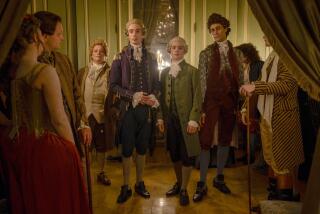Patriotism in every step, ball change
- Share via
Why don’t they make stars like James Cagney or John Wayne anymore? It’s partly because they don’t make Americans like Cagney or Wayne anymore. We’ve become too selfconscious -- maybe even too camera-conscious -- as well as too polarized and fragmented. Without even trying, these stars represented things about their country in the way they walked or smoked or set off fireworks.
Cagney stood for urban American drive and sass and gumption. Wayne became a walking dream of easy western confidence and fortitude. And they could share each other’s fan base; in many ways, they still do. That’s why their movies pop up on cable or in new DVD sets every holiday.
There are few better ways to salute July 4 than to curl up with Warner Home Video’s new “John Wayne/John Ford Film Collection,” heralded on the box as “The Star. The Director. The Movies that Define the American Spirit.” This rich, deep anthology marks one of the rare times that the most celebrated title is also the best. It’s the classic western “Stagecoach” (1939), which limns a complex portrait of American democracy on wagon wheels while containing one of the most jaw-dropping chases and nerve-racking showdowns ever filmed.
Director Ford knew how to energize Wayne and compose his broad features and frame within each shot so that he became an open-faced picture of rugged rural nobility. Wayne achieved major stardom in this film as the Ringo Kid. He helps to protect all the passengers, even the greedy or genteel hypocrites, from hostile Indians. But he becomes a knight gallant to the one shunned by all the others: Claire Trevor’s pretty, sad-eyed prostitute.
I think Ford and Wayne nearly matched that peak -- achieving a new, easy eloquence -- 10 years later with “She Wore a Yellow Ribbon,” the second of Ford’s “cavalry trilogy” (“Fort Apache,” contained here, was the first, “Rio Grande” the last). In this one, Wayne plays Capt. Nathan Brittles, who must halt the spread of a vast, pan-tribal Indian war after Custer’s defeat at Little Big Horn while passing down lessons of command to his lieutenants before his impending retirement.
Wayne had already played an older man in Howard Hawks’ “Red River,” giving a portrait of psychosis in some ways as remarkable as Humphrey Bogart’s in John Huston’s “The Treasure of the Sierra Madre” and Cagney’s in Raoul Walsh’s “White Heat.” But “She Wore a Yellow Ribbon” accents the virtues of the leathery sagebrush sage who could handle any job without breaking a sweat and who could make taciturnity seem belligerent. Every word Brittles says counts. He isn’t overly sensitive -- or at least not overtly sensitive -- but he feels the ties of family, community and country.
What Wayne does in this movie resembles the postwar reach for raw truth that was spreading from Broadway to Hollywood. Of course, he was taking his cues from Ford. In this last great phase of his career, Ford reacted to his recent World War II experience by framing profiles in courage while reaching back artistically to the visual and dramatic spontaneity of his silent westerns.
In “She Wore a Yellow Ribbon,” Wayne brings an audience inside qualities that in lesser performers could be dramatically intractable, like rough-hewn dignity and reticence. The extra second it takes for him to mute the emotion before barking out a command only adds depth to his authority, and when Ford gives him a chance to express his feelings directly -- at the graves of his wife and two daughters -- he has a mellow, rueful veracity.
Unlike “Stagecoach,” this movie does have grievous flaws: too much amateurish service comedy with Victor McLaglen as a drunken sergeant and too much incongruous glamour from Joanne Dru as the non-Army gal who fuels the competition between rich-boy 2nd Lt. Harry Carey Jr. and stalwart 1st Lt. John Agar.
But “She Wore a Yellow Ribbon” is one of the most magnificently photographed westerns ever made in color -- because cinematographer Winton Hoch succeeded in bringing a Frederic Remington palette to the big screen and because Ford suffused it with the stormy and stirring feelings of a post-Civil War country knitting itself back together on the western frontier. Although the movie hardly questions the role of the cavalry in the Indian Wars, Brittles and an Indian chief agree that they are too old to fight wars -- and that old men should stop wars. Throughout, Wayne is a virtuoso of restraint; no movie actor ever showed more exquisite control over values and emotions like faith, duty, honor or loyalty than Wayne does in this picture.
Cagney gets his due Tuesday. Turner Classic Movies uses “Yankee Doodle Dandy” to help anchor its July 4 gala. (It airs at 7:15 p.m.). Cagney won his only Oscar, as best actor of 1942, for his characterization of patriotic showman George M. Cohan. He filled it with exuberance, freshness and cock-of-the-walk wit -- and funneled all that into his phenomenally visceral and graceful dancing. He created a Horatio Alger hero with chutzpah: a wisecracking flag-waver.
Cagney’s acting here is a form of controlled euphoria. With breakneck ease, he expresses the galvanizing speed and ready-for-anything gumption of early20th-century America. Whether portraying Cohan in the pink of youth or sporting a sizable middle-aged paunch, Cagney moves as if he were a marionette pulling his own strings.
Imagine a wire running from Cagney’s rump through his neck, giving his torso and head a swiveling motion and letting his feet tap and his hands dangle, and you’ve got the basic Cagney dance posture. Tripping the light fantastic or hoofing like crazy, Cagney has split-second, make that nano-second, control. It allows him to tap like an entire percussion team and to fly like Peter Pan, all over the stage and even up the proscenium walls.
TCM precedes “Yankee Doodle Dandy” with Frank Capra’s “Mr. Smith Goes to Washington,” starring Jimmy Stewart. Capra, of course, was Ronald Reagan’s favorite director and Stewart one of his favorite actors.
In his own acting days, on a couple of occasions, Reagan proved himself worthy of their artistic company. Although Notre Dame football star George Gipp was the sort of legendary role that could reveal an actor’s feet of clay, Reagan played him cannily in “Knute Rockne, All-American” (1940), which brings up the tail end of TCM’s Independence Day salute (it airs at midnight). Reagan made it his career breakthrough, injecting suaveness and energy into an otherwise square and reverential movie.
Gipp doesn’t know he’s the answer to the prayers of Coach Rockne (Pat O’Brien) when the football whiz spots him fooling around on the playing field. When Rockne asks him to run the ball, Gipp naively responds, “How far?” Reagan imbues the question with the easy confidence of a fellow who’s used to outstripping expectations.
Reagan’s Gipp is no showboat; he’s one precocious college star, savvy and centered enough to kid Rockne about the coach’s attention to press coverage. And when Gipp dies of pneumonia, Reagan gives his deathbed request the weathered professionalism of vintage buddy movies: “Rock, someday when the team is up against it and the breaks are beating the boys, ask them to go out there with all they’ve got and win just one for the Gipper.” It sums up the combination of individualism and teamwork that used to characterize “Americanism” at its best.
Michael Sragow is a film critic at the Baltimore Sun, a Tribune company.
More to Read
Only good movies
Get the Indie Focus newsletter, Mark Olsen's weekly guide to the world of cinema.
You may occasionally receive promotional content from the Los Angeles Times.










